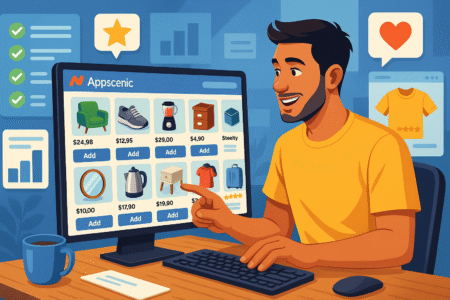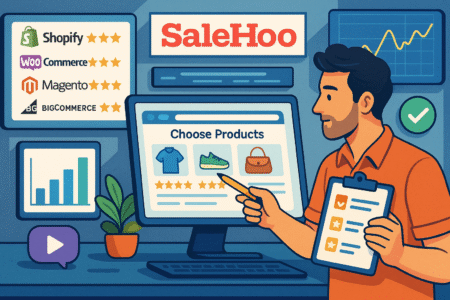Table of Contents
Are you looking to boost your e commerce marketing efforts but unsure where to start? Creating a winning e-commerce marketing plan can be challenging, but it’s the foundation for driving sales, building brand awareness, and ensuring long-term success.
In this article, we will answer crucial questions like how to set clear goals, choose the best marketing channels, and craft a strategy that engages your audience and converts visitors into loyal customers. Let’s dive into the key steps to build a successful e-commerce marketing strategy that works!
Understanding the Key Elements of E Commerce Marketing Success
Building a successful e-commerce marketing strategy requires a thorough understanding of its core elements. This includes developing clear goals, selecting the right marketing channels, and crafting engaging content that resonates with your target audience. I believe this foundation is crucial for success.
In my experience, an effective marketing strategy also involves consistent monitoring and adaptation. You need to track performance metrics, make data-driven adjustments, and always keep your audience’s evolving needs in mind. Doing so ensures long-term growth and profitability.
Why a Strong E Commerce Marketing Plan Is Essential
A solid marketing plan ensures that every aspect of your e-commerce business is working toward a common goal. Without it, businesses tend to drift, missing out on valuable opportunities. I suggest focusing on creating a clear roadmap that outlines your key objectives and tactics.
I find that when companies have a focused strategy, it becomes easier to track progress and adapt quickly. When your plan is clearly defined, each marketing effort is intentional, maximizing your chances for success. I’ve noticed how businesses with solid plans outperform their competitors.
Having a strong plan also helps allocate resources effectively. When I plan campaigns, I emphasize using time, money, and effort wisely. This avoids unnecessary waste and ensures that your marketing budget is utilized efficiently.
I recall clients benefiting immensely from a well-thought-out plan. It not only guided their marketing efforts but also provided clarity in decision-making. I always advise revisiting and revising the plan regularly.
Lastly, a comprehensive plan includes both short-term and long-term goals. I’ve found this balance allows for immediate wins while keeping an eye on future growth, ensuring consistent progress in a competitive market.
Defining Your Goals and Objectives
Clear goals give your e-commerce business direction. I believe setting measurable and achievable objectives is a crucial first step. Focus on metrics like increasing website traffic, improving conversion rates, and growing customer retention. This gives you a clear path forward.
I recommend using the SMART framework—specific, measurable, attainable, relevant, and time-bound goals. With this approach, I’ve noticed businesses achieve much more targeted success. When objectives are well-defined, your marketing efforts become more intentional and focused.
It’s vital to align your goals with your broader business objectives. I’ve seen companies excel when their marketing and business goals are in sync. This ensures that every marketing activity contributes directly to growth and success.
I suggest breaking down larger goals into smaller, actionable tasks. This makes it easier to track progress and stay motivated. When I set goals, I prefer starting with smaller milestones that build up to bigger wins over time.
Finally, I emphasize the importance of flexibility. While having clear goals is essential, I find that adapting your objectives based on market changes is equally critical for long-term success.
How to Choose the Right Marketing Channels.
Choosing the right marketing channels is vital to reach your target audience effectively. I believe each business has unique needs, so selecting the best platforms requires careful consideration of your audience’s behavior and preferences.
I recommend focusing on data to guide your decision. I’ve seen that channels like Google Ads, Facebook, and Instagram are particularly effective for many e-commerce businesses, but analyzing where your audience spends time ensures optimal results.
It’s important to diversify your efforts across multiple channels. I often advise businesses to use a combination of organic and paid methods, such as SEO and PPC, to maximize their visibility. This ensures that you’re not relying too heavily on one platform.
When evaluating channels, I always emphasize testing. I’ve noticed that trying different platforms and seeing what delivers the best return on investment helps refine your strategy. Don’t be afraid to pivot if certain channels underperform.
Lastly, I suggest optimizing your presence on each platform. Whether it’s social media, email marketing, or influencer partnerships, tailor your messaging and format to each channel to boost engagement and conversion.
Conducting Comprehensive Market Research for E Commerce

Conducting thorough market research is critical for e-commerce success. I think understanding your target audience’s needs, behavior, and preferences helps craft marketing messages that resonate. It also provides insights into industry trends that shape your marketing efforts.
Analyzing competitors is equally important. I recommend looking at what works for them and identifying areas where you can outperform. This enables you to position your e-commerce business uniquely, giving you a competitive edge.
Identifying Target Audiences
Identifying your target audience involves more than just knowing their demographics. I believe it’s essential to understand their pain points, desires, and buying behaviors. This knowledge allows you to craft marketing messages that truly connect with them.
I suggest starting by creating detailed buyer personas. These profiles help you visualize your ideal customers and better anticipate their needs. When I create personas, I focus on factors like age, location, interests, and challenges.
One thing I’ve learned is the value of segmenting your audience. Not all customers will respond to the same marketing messages. I find that tailoring content for specific segments—whether they are repeat buyers or first-time visitors—yields better engagement.
Understanding customer intent is another critical aspect. I advise using data from analytics tools to track how users interact with your site. This data helps you anticipate their next steps and adjust your marketing approach accordingly.
Finally, I focus on gathering direct feedback from customers. Surveys, reviews, and even social media comments give you invaluable insights into what your audience values most. I always recommend acting on this feedback to refine your approach.
Analyzing E-Commerce Competitors for Marketing Insights
Studying your competitors can reveal gaps in the market that your e-commerce business can exploit. I often look at their strategies to learn what works and what doesn’t. This analysis informs my own marketing decisions, allowing me to craft stronger campaigns.
I recommend starting by reviewing your competitors’ online presence. Look at their websites, social media activity, and content. I’ve found that seeing how they engage with customers can highlight opportunities for improvement in your strategy.
Next, I suggest examining their strengths and weaknesses. I’ve noticed that identifying what competitors do well—and where they fall short—can help you differentiate your brand. This way, you can focus on areas they overlook.
I also find it valuable to monitor their advertising efforts. By tracking competitors’ ads and promotions, you can gain insights into their targeting strategies. I recommend using tools like SEMrush to see which keywords they’re ranking for.
Lastly, consider how they handle customer service and feedback. I believe a responsive, helpful approach can set your brand apart. Learning from competitors’ customer interactions helps you improve your own engagement strategies.
Leveraging Market Trends to Improve E-Commerce Strategies
Leveraging market trends keeps your e-commerce marketing plan relevant. I’ve noticed that staying ahead of the curve ensures your business remains competitive. Whether it’s adopting new technology or capitalizing on seasonal trends, being proactive gives you an edge.
I recommend regularly reviewing industry reports and insights. I’ve found that knowing what’s coming next helps you plan campaigns that resonate with evolving customer needs. Trends like mobile commerce or sustainability can shape your strategy.
It’s important to be agile. I advise adjusting your marketing plan based on current trends, whether they involve new buying behaviors or technological advancements. This allows your e-commerce business to remain flexible and forward-thinking.
Incorporating emerging platforms is another way to stay ahead. I’ve seen how early adoption of trends like TikTok or influencer marketing has helped businesses reach new audiences quickly. I always suggest testing new platforms to see if they fit your strategy.
Lastly, I think it’s important to balance trends with proven strategies. While jumping on trends can be lucrative, I believe you should also rely on time-tested techniques like SEO and email marketing for long-term success.
Building a Compelling Brand for Your E-Commerce Business
Creating a compelling brand is essential for standing out in the crowded e-commerce landscape. I believe your brand needs to communicate your values, personality, and mission to build a strong connection with customers. This helps create brand loyalty and trust.
A memorable brand isn’t just about logos or colors; it’s about how customers perceive your business. I’ve noticed that brands with consistent messaging and a clear identity tend to perform better. Your brand story should resonate with your target audience and evoke emotion.
The Role of Brand Identity
Brand identity plays a crucial role in shaping how customers experience your business. I recommend defining your brand’s unique qualities—such as tone, voice, and design—to differentiate from competitors. A strong identity makes your business instantly recognizable.
Your brand identity should reflect your values and mission. I’ve seen that when businesses align their identity with their core values, customers connect on a deeper level. This emotional connection fosters brand loyalty and drives repeat purchases.
I believe consistency is key. When customers encounter the same brand elements across all touchpoints, they feel more comfortable and trusting. I advise maintaining uniformity in everything from your website’s design to your packaging materials.
I also highlight the importance of storytelling. Sharing your brand’s journey and vision makes your company more relatable. I’ve found that brands with compelling stories are more memorable and engaging to their audiences.
Lastly, I focus on the emotional aspect of branding. I emphasize how brands that evoke positive feelings—whether through humor, nostalgia, or inspiration—often see higher customer retention. This emotional bond strengthens the relationship with your audience.
Creating a Consistent Brand Message Across Platforms
Consistency in your messaging is essential for building trust with your audience. I suggest that your brand’s message should remain uniform across every platform—whether it’s on social media, your website, or email marketing campaigns.
I’ve noticed that when brands maintain consistent communication, it becomes easier for customers to understand what the company stands for. I recommend using the same tone, language, and visuals across platforms to create a cohesive brand experience.
Customers often interact with your business on multiple channels, so I advise tailoring your message slightly for each platform while keeping the core values intact. This approach allows for flexibility while maintaining a unified brand voice.
When creating content, I also recommend aligning it with your brand’s personality. I find that when your brand has a defined voice, it becomes easier to connect with your audience on a personal level, building loyalty over time.
I believe the more consistent your messaging is, the more trust you build. When customers see the same message across all platforms, they perceive your brand as reliable and credible, which positively impacts your sales and customer relationships.
How to Build Trust and Loyalty with E-Commerce Customers
Building trust is key to growing your e-commerce business. I’ve learned that trust comes from transparency, consistency, and providing real value. Customers need to feel confident in their decision to purchase from you, and that trust leads to loyalty.
One way to build trust is through excellent customer service. I’ve found that responsive, personalized service can make a lasting impression. Customers appreciate when their concerns are addressed quickly, and this makes them more likely to return.
I believe showing social proof, such as reviews and testimonials, is incredibly effective in building trust. I suggest displaying positive feedback prominently on your site to reassure potential customers of the quality of your products and services.
Another strategy I recommend is offering guarantees, like money-back policies. When customers know they have options if they’re not satisfied, they’re more likely to make a purchase. I’ve seen this strategy improve conversion rates and customer confidence.
Lastly, I emphasize the importance of maintaining open and honest communication. I always suggest that brands should be upfront about pricing, shipping times, and product details to avoid customer disappointment. This transparency fosters long-term loyalty.
Crafting a Content Marketing Strategy That Engages Customers

Engaging content is at the heart of a successful e-commerce marketing plan. I believe your content should provide value, educate, and entertain. By consistently delivering content that resonates with your audience, you can foster stronger relationships and increase conversions.
I suggest focusing on content that speaks directly to your audience’s needs and interests. Whether through blogs, videos, or social media, your content should reflect your brand’s personality while addressing the specific challenges your customers face.
Types of Content That Work Best in E-Commerce Marketing
Various types of content can help e-commerce businesses thrive. I recommend using a mix of blogs, videos, infographics, and product guides to engage different segments of your audience. Each content type serves a unique purpose in building trust and driving sales.
I’ve noticed that how-to guides and tutorials work particularly well for educating customers about your products. I believe offering valuable insights and practical advice increases the likelihood of conversions, as it positions your brand as a helpful resource.
Incorporating video content is essential. I’ve seen videos perform better in terms of engagement and conversions. Whether it’s product demonstrations or customer testimonials, video content is dynamic and helps capture your audience’s attention quickly.
I also advise creating engaging visuals like infographics. Visual content is more digestible and shareable, making it perfect for platforms like Pinterest and Instagram. I’ve found that these visuals enhance brand recall and generate more social shares.
Lastly, I suggest leveraging user-generated content. I’ve seen how content created by customers—such as photos or reviews—boosts credibility and encourages new visitors to trust your brand. This organic content is often more relatable to prospective customers.
How to Leverage Blogs and Videos for E-Commerce Growth
Blogging and video content are two powerful tools for e-commerce growth. I find that blogging helps drive organic traffic by improving your website’s SEO, while video content keeps users engaged longer, leading to higher conversions.
I suggest using your blog to address common customer questions or industry trends. This positions your business as an expert in your niche. I’ve seen how businesses that consistently provide valuable content see significant improvements in search engine rankings.
Videos, on the other hand, allow for more dynamic storytelling. I believe product demonstrations, behind-the-scenes looks, and customer testimonials are effective at showcasing your products in action, helping customers make informed purchasing decisions.
Another strategy I’ve found successful is creating educational video series. By offering tutorials or explainer videos, you provide extra value to your audience, which builds trust and encourages repeat visits to your site.
I also advise repurposing blog content into videos. I’ve noticed that this multiplies the value of your content and ensures you’re reaching both readers and visual learners, expanding your audience and improving your engagement across platforms.
Importance of User-Generated Content in E-Commerce Success
User-generated content (UGC) is an incredibly powerful asset for e-commerce businesses. I’ve seen UGC drive higher engagement and boost credibility. It’s authentic, relatable, and shows potential customers how real people interact with your products.
I recommend encouraging your customers to share photos, reviews, or testimonials. When others see real users enjoying your products, it creates social proof and builds trust. I’ve noticed that UGC often leads to increased conversions and repeat sales.
UGC also provides a wealth of content for your marketing efforts. I suggest sharing customer photos on social media, featuring testimonials in emails, and displaying reviews on your product pages. This type of content often performs better than traditional ads.
I’ve also learned that UGC fosters a sense of community. When customers contribute content, they feel more connected to your brand. This strengthens loyalty and encourages them to remain long-term customers, driving recurring revenue.
Lastly, I recommend incentivizing UGC. Whether through contests, rewards, or shout-outs, encouraging customers to share their experiences leads to a continuous stream of fresh, authentic content that can greatly enhance your e-commerce marketing strategy.
Optimizing Your E-Commerce Website for Higher Conversions
Optimizing your e-commerce website is crucial for increasing conversions and improving overall sales performance. I believe focusing on key areas like user experience, mobile optimization, and a streamlined checkout process can significantly boost customer satisfaction and sales.
Conversion optimization isn’t just about making your site look good—it’s about ensuring the shopping experience is smooth and intuitive. I’ve noticed that when websites are easy to navigate, customers are more likely to complete purchases, reducing bounce rates.
Improving User Experience to Boost E-Commerce Sales
User experience (UX) plays a critical role in driving e-commerce sales. I recommend focusing on fast loading times, clear navigation, and intuitive design to enhance the shopping journey. I’ve learned that when users enjoy a seamless experience, they are more likely to make purchases.
A simple and clean design improves customer engagement. I suggest eliminating clutter on your website, focusing on straightforward layouts that guide users easily. I’ve noticed that minimalistic designs reduce distractions and help shoppers find what they need faster.
In my experience, personalized experiences go a long way in increasing sales. I suggest incorporating features like product recommendations based on past behavior, which makes users feel understood and valued. This personalization often leads to repeat purchases.
I also emphasize the importance of search functionality. I think having a robust, easy-to-use search bar with smart suggestions helps customers quickly locate the products they’re looking for. When users can find what they need easily, conversion rates tend to increase.
Lastly, I believe consistency in design and messaging helps create a trustworthy brand. I recommend keeping your fonts, colors, and tone uniform across all pages. This consistency reassures customers and gives your brand a professional, reliable feel.
Mobile Optimization Strategies for E-Commerce Websites
With most online shoppers browsing via smartphones, mobile optimization is essential. I suggest ensuring your e-commerce site is fully responsive and works flawlessly on all devices. I’ve noticed that mobile-friendly sites often outperform competitors with desktop-only designs.
Speed is a critical factor for mobile shoppers. I recommend using compressed images, simplified code, and streamlined navigation to improve load times on mobile devices. Faster sites keep visitors engaged and reduce bounce rates, especially for impatient mobile users.
I also believe touch-friendly design is important. I’ve found that mobile users appreciate larger buttons, easy-to-read text, and simple scrolling. When I design for mobile, I make sure to minimize the need for zooming or pinching, which can frustrate users.
Mobile payment options are another game-changer. I suggest offering mobile-optimized payment gateways, such as Apple Pay or Google Wallet, which speed up checkout. I’ve noticed that simplified payment options reduce friction and increase the likelihood of conversion.
I emphasize the importance of testing your site on various devices. I suggest using tools to preview how your website performs across different screen sizes and operating systems. This helps catch any usability issues that could prevent mobile users from converting.
How to Reduce Cart Abandonment With Optimized Checkout
Cart abandonment is a major challenge for e-commerce businesses, but I believe an optimized checkout can reduce this issue. Simplifying the checkout process helps keep customers engaged and more likely to complete their purchase.
I’ve found that reducing the number of steps in checkout can significantly improve conversion rates. I recommend allowing guest checkouts so customers don’t have to create an account, which often deters users from completing their purchase.
Clear progress indicators also help reduce cart abandonment. I think showing users how far they’ve come in the process reassures them and keeps them moving forward. A visible progress bar creates a sense of momentum, encouraging customers to complete their order.
In my experience, offering multiple payment options is crucial. I suggest integrating popular gateways like PayPal, credit cards, and mobile payment options. When customers have their preferred method available, they’re more likely to finalize their purchase.
I’ve also learned that providing clear shipping information upfront helps reduce cart abandonment. Unexpected shipping costs or unclear delivery times often lead to customers abandoning their carts. Transparency in this area helps build trust and reduces frustration.
Lastly, I recommend sending cart abandonment reminders via email. These reminders nudge customers to return to their cart, often offering a discount or limited-time offer. I’ve noticed that timely follow-ups can recover a significant portion of abandoned sales.
Implementing Effective SEO Strategies for E-Commerce Websites

SEO is vital for driving organic traffic to your e-commerce website. I’ve learned that businesses that prioritize SEO see long-term gains in visibility and customer acquisition. By optimizing your site for search engines, you can attract potential buyers actively searching for your products.
Effective e-commerce SEO involves both on-page and off-page techniques. I believe a combination of keyword optimization, quality content, and strategic link-building can significantly boost your site’s rankings. This helps you stay ahead of competitors and capture more search traffic.
Why SEO Matters in E-Commerce Marketing
SEO plays a fundamental role in your e-commerce marketing strategy. I think it helps increase your site’s visibility on search engines, driving organic traffic that’s more likely to convert. Customers searching for products online are often ready to buy, making SEO an essential tool for sales growth.
I find that SEO helps build credibility. When your site ranks high on search engines, customers perceive your brand as trustworthy and authoritative. I believe this credibility leads to more clicks and conversions, as users trust top-ranking results over lower-ranked options.
SEO also supports long-term growth. Unlike paid ads that stop driving traffic once your budget is spent, I suggest investing in SEO for sustainable, organic traffic. Once your site ranks well, you can enjoy consistent visitors without ongoing ad costs.
I’ve learned that SEO increases brand visibility across a wide range of search queries. When you optimize your content for various keywords, you capture traffic from different stages of the buying journey. This broadens your audience and increases conversion opportunities.
I believe SEO allows you to compete with larger companies. By focusing on niche keywords and optimizing your product pages, you can rank alongside bigger competitors, even with a smaller marketing budget. This levels the playing field in a competitive market.
On-Page SEO Techniques to Improve E-Commerce Traffic
On-page SEO is critical for improving your site’s search rankings. I recommend optimizing elements like titles, meta descriptions, and product page content to ensure search engines can easily understand your site. This helps improve visibility for relevant search queries.
I always emphasize the importance of keyword research. I advise finding relevant, high-traffic keywords that match your products and integrating them naturally throughout your content. When used correctly, these keywords help drive more targeted traffic to your site.
Optimizing product descriptions is another powerful on-page SEO tactic. I recommend writing detailed, unique descriptions that highlight your product’s features and benefits. I’ve found that this not only helps with rankings but also improves conversions by providing valuable information to customers.
I also suggest optimizing your images by using descriptive alt text and compressing files for faster load times. Search engines can’t “see” images, so I find that alt text helps them understand the content, which improves visibility in image searches.
Lastly, I advise ensuring that your site is mobile-friendly and loads quickly. I’ve noticed that search engines prioritize websites with excellent user experience, and improving speed and responsiveness can give your site a boost in rankings.
How to Use Product Descriptions to Drive Organic Traffic
Product descriptions can do more than just inform customers—they can drive organic traffic when optimized properly. I suggest using relevant keywords in your descriptions to help search engines understand the content, making it more likely to appear in search results.
I’ve noticed that focusing on benefits over features improves both SEO and user engagement. I advise describing how your product solves a customer’s problem, as this type of content tends to perform better in search rankings and resonates more with buyers.
Unique descriptions are key. I always recommend avoiding manufacturer descriptions, as duplicate content can harm your SEO. Writing original content for each product page helps your site rank higher while offering customers valuable insights.
Incorporating long-tail keywords is another effective strategy. I’ve learned that these specific phrases often have less competition, making it easier for your pages to rank. I suggest finding phrases that match customer queries and integrating them naturally into your descriptions.
Lastly, I believe formatting matters. Using bullet points, headers, and short paragraphs makes your descriptions more readable. This improves the user experience and keeps customers engaged, while also making it easier for search engines to crawl your content.
Leveraging Social Media for E-Commerce Brand Awareness
Social media is a powerful tool for boosting e-commerce brand awareness. I believe businesses that strategically use platforms like Instagram, Facebook, and TikTok can engage customers, build trust, and increase visibility. Your social presence sets the stage for brand growth.
In my experience, creating engaging content that resonates with your audience on these platforms helps foster a community around your brand. By sharing relatable, valuable posts, businesses can connect with their audience in an authentic way, driving brand loyalty.
Choosing the Best Social Platforms for E-Commerce Marketing
Selecting the right social platforms for your e-commerce business is crucial. I suggest focusing on where your target audience spends their time. For fashion brands, Instagram is highly visual, while for B2B e-commerce, LinkedIn might be more effective.
I find it helpful to experiment with multiple platforms and analyze performance. By tracking engagement rates and conversions, you can see which platform delivers the best ROI. I’ve noticed that businesses often perform better by narrowing down to 2-3 platforms.
I also recommend diversifying content formats. Each platform offers unique opportunities—Instagram Stories, TikTok videos, and Facebook Groups all engage users differently. I advise adapting your content style to fit the platform while keeping your messaging consistent.
Understanding platform algorithms is essential. I’ve learned that boosting your visibility requires staying current with algorithm changes and optimizing your posts for maximum reach. Engaging content that encourages interaction helps your posts rank higher.
Lastly, I suggest taking advantage of platform-specific features. Instagram Shopping, Facebook Marketplace, and Pinterest’s product pins offer e-commerce tools that make it easier for users to discover and purchase your products directly through social channels.
Engaging with Your Audience Through Social Media Content
Engagement is key to building a strong presence on social media. I suggest interacting with your audience regularly through comments, polls, and live Q&A sessions. I’ve found that this personal touch encourages brand loyalty and creates a sense of community.
Content that resonates with your audience drives higher engagement. I advise using relatable posts, behind-the-scenes content, and customer stories to connect emotionally with your followers. I’ve seen how storytelling can transform followers into loyal customers.
I think incorporating user-generated content (UGC) is one of the most powerful ways to engage. UGC builds trust and showcases real customer experiences with your products. I suggest encouraging your audience to share their own content and then highlighting it on your feed.
In my experience, contests and giveaways can dramatically increase engagement. I’ve noticed that people love the excitement of winning something, and it’s a fun way to boost your visibility. Encourage sharing and tagging to expand your reach further.
Finally, I believe consistency is key. I advise posting regularly to keep your audience engaged and informed. Developing a content calendar ensures you stay organized and maintain an active presence, which helps keep your followers interested and coming back for more.
Influencer Marketing Tactics That Boost E-Commerce Sales
Influencer marketing has become a powerful tool for e-commerce brands. I recommend partnering with influencers who genuinely align with your brand values. I’ve noticed that authentic collaborations drive trust and often lead to higher conversions.
Choosing the right influencers is critical. I suggest focusing on micro-influencers with highly engaged followers. I find that they often have more intimate, loyal audiences who trust their recommendations, leading to higher sales.
I advise setting clear goals for your influencer campaigns, such as increasing brand awareness or driving traffic to your site. By having specific objectives, I’ve found it easier to measure campaign success and adjust your strategy accordingly.
Another tactic I recommend is giving influencers creative freedom. I’ve seen that influencer-generated content performs best when it feels organic rather than overly scripted. Allowing influencers to present your products in a way that fits their style resonates more with their followers.
Lastly, I suggest using unique discount codes or affiliate links in influencer posts. This not only drives sales but also makes it easy to track the effectiveness of each influencer partnership. I’ve found that offering limited-time discounts encourages immediate purchases.
Running Paid Advertising Campaigns to Drive E-Commerce Traffic

Paid advertising is a fast, effective way to drive traffic to your e-commerce site. I believe that when ads are targeted well and paired with a clear call to action, they can significantly boost conversions. Paid campaigns let you reach a broader, highly relevant audience.
Careful planning is essential for successful paid campaigns. I advise focusing on platforms where your target audience is active, whether it’s Google Ads, Facebook, or Instagram. Monitoring performance closely allows you to optimize for the best results.
Best Practices for Google Ads in E-Commerce Marketing
Google Ads can be a game-changer for e-commerce brands. I suggest using keyword research to target the most relevant search terms for your products. I’ve seen that when businesses bid on high-intent keywords, they attract shoppers ready to buy.
I recommend creating specific ad groups for different product categories. This helps tailor your ads to match user searches more closely, improving click-through rates. I’ve noticed that highly relevant ads often lead to better quality scores and lower costs per click.
Writing compelling ad copy is key. I believe using power words like “exclusive,” “limited time,” or “best-selling” captures attention and encourages clicks. Crafting persuasive headlines and descriptions can set your ad apart from competitors in the crowded marketplace.
I advise setting up retargeting campaigns within Google Ads. Retargeting ads remind users of products they’ve viewed but haven’t purchased yet, driving them back to complete the sale. I’ve seen this approach significantly increase conversion rates over time.
Finally, I suggest continually optimizing your campaigns. I think reviewing data regularly—like click-through rates, conversion rates, and return on ad spend—helps identify what’s working and where adjustments are needed to maximize your results.
How Facebook Ads Can Elevate Your E-Commerce Sales
Facebook Ads offer robust targeting options to reach specific audiences. I suggest using Facebook’s targeting features to focus on demographics, interests, and behaviors that match your ideal customer. I’ve seen how precise targeting can elevate e-commerce sales.
I think video ads are particularly effective on Facebook. In my experience, videos capture attention quickly and showcase products in a dynamic way. I suggest creating short, engaging videos that highlight your product’s key benefits to drive clicks and conversions.
Carousel ads are another powerful tool. I’ve found that showcasing multiple products in a single ad increases engagement and provides more opportunities to capture interest. I suggest using carousel ads to feature top-selling items or collections.
I also recommend A/B testing your ads. I’ve noticed that testing different headlines, images, and ad formats allows you to refine your strategy and discover what resonates most with your audience. This helps improve your ad performance over time.
Lastly, I believe retargeting on Facebook can bring back lost customers. I suggest showing ads to users who have abandoned their cart or visited your product pages. These reminders often nudge shoppers toward completing their purchase.
Maximizing ROI with Retargeting Ads for E-Commerce
Retargeting ads are a powerful way to maximize return on investment (ROI) by re-engaging visitors who didn’t convert on their first visit. I recommend using these ads to remind potential customers of the products they were interested in, often leading to more conversions.
I suggest setting up retargeting campaigns for specific actions—like abandoned carts, product views, or sign-ups. I’ve found that personalized ads showing the exact products users left behind encourage them to return and complete their purchase.
Offering a discount in retargeting ads can make a big difference. I believe an exclusive offer, such as free shipping or 10% off, gives shoppers the extra nudge they need to finalize their order. I’ve seen this tactic work wonders for increasing conversion rates.
Dynamic retargeting is another strategy I’ve found highly effective. I suggest using dynamic ads to show users products they’ve recently viewed. This personalization feels more relevant and increases the likelihood of a conversion compared to generic ads.
Lastly, I advise monitoring the frequency of retargeting ads. I think striking the right balance is key—you want to remind customers without overwhelming them. I suggest capping the number of impressions per user to avoid ad fatigue and maintain a positive brand experience.
Using Email Marketing to Nurture E-Commerce Customer Relationships
Email marketing remains one of the most effective ways to build strong relationships with e-commerce customers. I’ve found that by delivering personalized, timely emails, businesses can keep their customers engaged and encourage repeat purchases. A thoughtful email strategy fosters long-term loyalty.
Regular communication with your audience helps build trust. I believe that consistent updates, personalized product recommendations, and exclusive offers remind customers of your brand, keeping them connected. The more valuable your emails, the more likely customers are to stay loyal.
Crafting Effective Email Campaigns for E-Commerce Conversions
Crafting high-converting email campaigns requires a deep understanding of your audience’s needs. I suggest creating personalized content that speaks directly to your customers’ interests. Personalized subject lines and tailored offers boost open and click-through rates, increasing sales potential.
I also recommend using a clear and compelling call-to-action (CTA) in every email. I’ve found that a well-placed, action-driven CTA encourages users to make quick decisions, often resulting in more conversions. CTAs should be visible and direct, guiding customers to their next step.
Segmenting your email list is another crucial strategy. I believe targeted email campaigns perform better than generic ones. When I personalize emails based on user behavior—such as recent purchases or abandoned carts—I’ve noticed higher engagement and stronger results.
I think email design plays a big role in conversions too. I suggest using clean, visually appealing layouts that highlight your key message and products. Eye-catching images and easy-to-read text enhance user experience, making customers more likely to engage with your content.
Finally, I advise testing different email elements, such as subject lines and send times, to optimize performance. A/B testing has helped me refine campaigns for higher conversion rates. Continuously experimenting ensures your email strategy remains effective over time.
Segmenting Your Email List for Personalized E-Commerce Marketing
Segmenting your email list allows you to deliver more relevant content. I suggest breaking down your audience into categories based on factors like purchase history, browsing behavior, or location. This helps you tailor your messages to meet specific customer needs.
I find that segmenting by purchase behavior can be highly effective. For example, sending exclusive offers to repeat customers or targeting first-time buyers with welcome discounts can drive further engagement. Personalized offers create a sense of exclusivity and connection.
Segmenting by demographics is another useful tactic. I believe creating targeted emails for different age groups, locations, or genders ensures your messaging resonates with each audience. I’ve seen that demographic-based campaigns often lead to higher engagement and conversions.
I also recommend using behavioral data for segmentation. For instance, I focus on users who abandoned their carts or viewed certain products and send follow-up emails tailored to their interests. Behavioral targeting often leads to conversions by tapping into customer intent.
Lastly, I think it’s helpful to segment based on email engagement. Grouping users by their activity—whether they are active openers or inactive subscribers—allows you to customize your approach. I advise sending re-engagement campaigns to inactive subscribers and rewards to loyal readers.
How to Use Automation for Efficient E-Commerce Email Marketing
Automation streamlines your email marketing efforts while maintaining personalization. I believe automated email workflows—such as welcome series, abandoned cart reminders, and post-purchase follow-ups—can nurture customer relationships without requiring constant manual intervention.
I suggest setting up automated welcome emails for new subscribers. A warm, personalized welcome makes a great first impression. I’ve seen that brands with automated welcome sequences are more likely to turn subscribers into long-term customers.
Abandoned cart emails are another must-have in any e-commerce automation strategy. I’ve noticed that sending automated reminders to users who left items in their cart can significantly recover lost sales. Adding incentives like free shipping can make the offer even more appealing.
I think post-purchase follow-ups help build loyalty. I recommend setting up an automated thank-you email after each purchase, perhaps with a discount code for future orders. This small gesture encourages repeat business and strengthens customer relationships.
Automation also supports upselling and cross-selling. I advise using automation to recommend complementary products based on past purchases. Automated product suggestions tailored to customer preferences can drive additional sales without being intrusive.
Lastly, I believe email automation saves time while delivering value. I suggest regularly monitoring and optimizing automated workflows to ensure they remain relevant and effective. Continuous improvement helps you maximize efficiency and customer satisfaction.
Tracking and Analyzing E-Commerce Marketing Performance

Tracking your e-commerce marketing performance is essential for understanding what’s working and where you can improve. I believe regularly reviewing key metrics provides valuable insights that help optimize your strategy. By measuring performance, you can make data-driven decisions to drive growth.
I suggest focusing on both short-term and long-term performance. Short-term metrics like email open rates and sales can indicate immediate success, while long-term data—such as customer retention and lifetime value—gives a broader view of your strategy’s effectiveness.
Key Performance Indicators (KPIs) for E-Commerce Success
Key performance indicators (KPIs) are essential for measuring e-commerce success. I recommend tracking metrics such as conversion rate, customer acquisition cost, and average order value. These KPIs give you a clear picture of how well your marketing efforts are performing.
I believe customer lifetime value (CLV) is one of the most important KPIs. It shows how much revenue you can expect from a customer over their relationship with your brand. A higher CLV indicates stronger customer loyalty and a well-executed marketing strategy.
Tracking your cart abandonment rate is crucial too. I suggest monitoring how often users leave items in their cart without purchasing. High cart abandonment rates can signal issues with your checkout process, pricing, or shipping options, which may need addressing.
I also advise measuring your email marketing performance through open rates, click-through rates, and conversion rates. These KPIs help you understand how well your emails resonate with your audience and where adjustments may be needed to improve engagement.
Lastly, I think return on ad spend (ROAS) is critical for paid advertising campaigns. This KPI measures how much revenue you earn for each dollar spent on ads. A high ROAS shows that your ads are effective, while a low ROAS indicates the need for optimization.
How to Use Analytics Tools to Optimize E-Commerce Strategies
Analytics tools provide the insights needed to fine-tune your e-commerce strategy. I recommend using tools like Google Analytics and Shopify’s built-in analytics to monitor traffic, user behavior, and sales performance. These tools offer detailed reports that guide decision-making.
I think tracking user behavior on your site is essential. I suggest using heat maps and session recordings to see where visitors are spending the most time. This helps you identify any friction points in the user journey and make necessary improvements.
Monitoring traffic sources is another important strategy. I advise analyzing where your visitors are coming from—whether it’s organic search, social media, or paid ads. Understanding your top-performing channels helps you allocate your marketing budget more effectively.
I believe A/B testing is a valuable tool for optimization. I recommend experimenting with different headlines, product descriptions, and landing pages to see what drives the most engagement. Analytics tools make it easy to track which variations perform best.
Lastly, I suggest tracking conversion funnels to see where users drop off during the purchase process. By identifying weak spots in the funnel, such as product pages or checkout steps, you can make targeted changes to increase conversions.
Adjusting Your E-Commerce Plan Based on Data Insights
Adjusting your e-commerce marketing plan based on data is critical for staying competitive. I believe regularly reviewing performance metrics allows you to identify what’s working and make necessary changes. Continuous improvement ensures that your strategy stays effective.
I advise using data to refine your audience targeting. If your current audience segments aren’t converting well, I suggest adjusting your targeting based on behavioral data, interests, or demographics. Fine-tuning your audience can improve overall campaign performance.
Analyzing which products are performing well can help shape your marketing efforts. I recommend promoting your best-sellers more prominently and offering discounts on slower-moving products. This approach helps maximize sales and reduce excess inventory.
I also suggest reallocating your marketing budget based on campaign performance. If certain channels—like social media or email—are driving better results, I recommend increasing your investment in those areas to maximize returns.
I think reviewing customer feedback is invaluable. Analyzing reviews, surveys, and social media comments gives you insight into customer preferences and pain points. I advise using this feedback to make product or service improvements that enhance the customer experience.
Lastly, I believe it’s important to stay flexible. E-commerce trends and customer behavior can shift quickly, so I recommend being open to changing your approach. By regularly reviewing data and staying agile, you can adapt to new challenges and opportunities.






